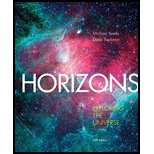
Horizons: Exploring the Universe (MindTap Course List)
14th Edition
ISBN: 9781305960961
Author: Michael A. Seeds, Dana Backman
Publisher: Cengage Learning
expand_more
expand_more
format_list_bulleted
Textbook Question
Chapter 18, Problem 5RQ
Why do astronomers conclude that none of the Jovian planets’ rings can be left over from the formation of the planets?
Expert Solution & Answer
Want to see the full answer?
Check out a sample textbook solution
Students have asked these similar questions
Please solve and answer all parts of the question correctly please. Thank you!!
Please solve and answer this question correctly please. Thank you!!
Please solve and answer the question correctly please. Thank you!!
Chapter 18 Solutions
Horizons: Exploring the Universe (MindTap Course List)
Ch. 18 - Why is Jupiter so much richer in hydrogen and...Ch. 18 - How can Jupiter have a liquid interior and not...Ch. 18 - How does the dynamo effect account for the...Ch. 18 - Why are the belts and zones on Saturn less...Ch. 18 - Why do astronomers conclude that none of the...Ch. 18 - How can a moon produce a gap in a planetary ring...Ch. 18 - Explain why the amount of geological activity on...Ch. 18 - Prob. 8RQCh. 18 - Prob. 9RQCh. 18 - Prob. 10RQ
Ch. 18 - What are the seasons on Uranus like?Ch. 18 - Prob. 12RQCh. 18 - What evidence is there that Neptune’s moon Triton...Ch. 18 - How do astronomers account for the origin of...Ch. 18 - What evidence indicates that catastrophic impacts...Ch. 18 - Prob. 16RQCh. 18 - Some astronomers argue that Jupiter and Saturn are...Ch. 18 - Prob. 2DQCh. 18 - What is the maximum angular diameter of Jupiter as...Ch. 18 - What is the angular diameter of Jupiter as seen...Ch. 18 - Measure the polar and equatorial diameters of...Ch. 18 - If you observe light reflected from Saturn’s...Ch. 18 - One way to recognize a distant planet is by its...Ch. 18 - If Uranus’s epsilon ring is 50 km wide and the...Ch. 18 - If Neptune’s clouds have a temperature of 60 K, at...Ch. 18 - Prob. 8PCh. 18 - Prob. 9PCh. 18 - The orbital period of Charon is given in the...Ch. 18 - Prob. 1LTLCh. 18 - Prob. 2LTLCh. 18 - Prob. 3LTL
Additional Science Textbook Solutions
Find more solutions based on key concepts
To test your knowledge, discuss the following topics with a study partner or in writing ideally from memory. Th...
HUMAN ANATOMY
Choose the best answer to each of the following. Explain your reasoning. If Earth were twice as far as it actua...
Cosmic Perspective Fundamentals
11. In the early 1800s, French naturalist Jean Baptiste Lamarck suggested that the best explanation for the rel...
Campbell Biology: Concepts & Connections (9th Edition)
How does the removal of hydrogen atoms from nutrient molecules result in a loss of energy from the nutrient mol...
SEELEY'S ANATOMY+PHYSIOLOGY
Calculate the lattice energy of CaCl2 using a Born-Haber cycle and data from Appendices F and L and Table 7.5. ...
Chemistry & Chemical Reactivity
Knowledge Booster
Learn more about
Need a deep-dive on the concept behind this application? Look no further. Learn more about this topic, physics and related others by exploring similar questions and additional content below.Similar questions
- In a scene from The Avengers (the first one) Black Widow is boosted directly upwards by Captain America, where she then grabs on to a Chitauri speeder that is 15.0 feet above her and hangs on. She is in the air for 1.04 s. A) With what initial velocity was Black Widow launched? 1 m = 3.28 ft B) What was Black Widow’s velocity just before she grabbed the speeder? Assume upwards is the positive direction.arrow_forwardIn Dark Souls 3 you can kill the Ancient Wyvern by dropping on its head from above it. Let’s say you jump off the ledge with an initial velocity of 3.86 mph and spend 1.72 s in the air before hitting the wyvern’s head. Assume the gravity is the same as that of Earth and upwards is the positive direction. Also, 1 mile = 1609 m. A) How high up is the the ledge you jumped from as measured from the wyvern’s head? B) What is your velocity when you hit the wyvern?arrow_forwardA) If Yoshi flings himself downwards at 9.76 miles per hour to hit an enemy 10.5 m below him, how fast is Yoshi traveling when he hits the enemy? 1 mile = 1609 marrow_forward
arrow_back_ios
SEE MORE QUESTIONS
arrow_forward_ios
Recommended textbooks for you
 AstronomyPhysicsISBN:9781938168284Author:Andrew Fraknoi; David Morrison; Sidney C. WolffPublisher:OpenStax
AstronomyPhysicsISBN:9781938168284Author:Andrew Fraknoi; David Morrison; Sidney C. WolffPublisher:OpenStax An Introduction to Physical SciencePhysicsISBN:9781305079137Author:James Shipman, Jerry D. Wilson, Charles A. Higgins, Omar TorresPublisher:Cengage Learning
An Introduction to Physical SciencePhysicsISBN:9781305079137Author:James Shipman, Jerry D. Wilson, Charles A. Higgins, Omar TorresPublisher:Cengage Learning Foundations of Astronomy (MindTap Course List)PhysicsISBN:9781337399920Author:Michael A. Seeds, Dana BackmanPublisher:Cengage Learning
Foundations of Astronomy (MindTap Course List)PhysicsISBN:9781337399920Author:Michael A. Seeds, Dana BackmanPublisher:Cengage Learning


Astronomy
Physics
ISBN:9781938168284
Author:Andrew Fraknoi; David Morrison; Sidney C. Wolff
Publisher:OpenStax

An Introduction to Physical Science
Physics
ISBN:9781305079137
Author:James Shipman, Jerry D. Wilson, Charles A. Higgins, Omar Torres
Publisher:Cengage Learning

Foundations of Astronomy (MindTap Course List)
Physics
ISBN:9781337399920
Author:Michael A. Seeds, Dana Backman
Publisher:Cengage Learning


Kepler's Three Laws Explained; Author: PhysicsHigh;https://www.youtube.com/watch?v=kyR6EO_RMKE;License: Standard YouTube License, CC-BY